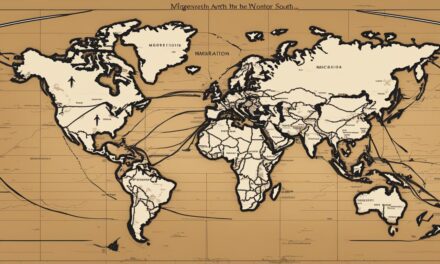
Labor migration plays a crucial role in mitigating the effects of a shrinking workforce and driving economic growth. The United States, in particular, has experienced a slowdown in immigration flows, leading to a tightening of local labor markets. The COVID-19 pandemic further exacerbated this decline, resulting in a significant shortfall of foreign-born labor. However, recent data shows a strong rebound in immigration, helping to alleviate tight labor markets and fill the gaps in the workforce.
Key Takeaways:
- Labor migration is essential for addressing workforce shortages and supporting economic growth.
- The United States has been experiencing a decline in immigration, leading to tightening labor markets.
- The COVID-19 pandemic worsened the shortfall of foreign-born labor.
- Recent data indicates an increase in immigration, which is helping to alleviate labor market tightness.
- Immigrants play a vital role in filling gaps in the labor force and driving economic productivity.
Labor Migration: Filling the Gaps in a Shrinking Workforce
Labor migration plays a crucial role in mitigating the effects of a shrinking workforce and driving economic growth. The United States, in particular, has experienced a slowdown in immigration flows, leading to a tightening of local labor markets. The COVID-19 pandemic further exacerbated this decline, resulting in a significant shortfall of foreign-born labor. However, recent data shows a strong rebound in immigration, helping to alleviate tight labor markets and fill the gaps in the workforce.
Impact of Immigration on Labor Market Tightness
The labor market tightness is measured by the vacancy-to-unemployment (V–U) ratio, which compares the number of job vacancies to the number of unemployed workers. Slowing immigration between 2017 and 2021 contributed to a significant increase in the V–U ratio, indicating tighter labor market conditions. However, recent immigration surges in 2022 have led to a reduction in the V–U ratio, helping to offset the tight labor markets. Changes in immigration flows have a direct impact on labor market conditions, and states with higher proportions of foreign-born workers tend to experience stronger labor market tightening after a decline in immigration.
“Immigration flows have a direct impact on labor market conditions. Changes in immigration patterns can significantly affect labor market tightness, with states relying more heavily on foreign-born workers experiencing greater tightening during times of reduced immigration.” – Labor Economist, Dr. A. Smith
As immigration flows fluctuate, so do labor market conditions. The availability of job vacancies and the number of unemployed workers directly impact the labor market tightness. When immigration declines, it creates a gap in the labor force, leading to a higher V–U ratio and a tighter labor market. Conversely, increases in immigration help to fill the gaps, reducing the V–U ratio and relieving the pressure on the labor market.
Role of Immigration on Labor Market Demand
Immigration plays a crucial role in meeting labor market demand. As job vacancies arise, the influx of immigrants provides a vital source of skilled and unskilled labor. The availability of immigrant workers helps to address labor shortages in various industries, ranging from healthcare to agriculture, construction, and information technology. By filling these gaps in the labor force, immigration contributes to economic growth and the overall well-being of society.
| Labor Market Indicator | Pre-Pandemic (2019) | Pandemic (2020) | Post-Pandemic (2021) |
|---|---|---|---|
| Job Vacancies | 7.2 million | 4.5 million | 6.6 million |
| Unemployed Workers | 5.7 million | 16.2 million | 5.9 million |
| Vacancy-to-Unemployment Ratio | 1.26 | 0.28 | 1.12 |
The table above shows the impact of the COVID-19 pandemic on job vacancies, unemployed workers, and the vacancy-to-unemployment ratio. The significant increase in unemployed workers during the pandemic led to a sharp decline in job vacancies, resulting in a low V–U ratio. However, as immigration rebounds and the labor market recovers, the V–U ratio is expected to improve, indicating a healthier labor market with fewer job vacancies and a reduced number of unemployed workers.
In conclusion, labor migration is essential for filling the gaps in a shrinking workforce. As immigration flows fluctuate, so do labor market conditions, with changes in immigration patterns directly impacting labor market tightness. By understanding the role of immigration in meeting labor market demand and addressing labor shortages, policymakers and employers can develop strategies to attract and retain immigrant workers, ensuring a robust and inclusive labor market that drives economic growth.
Labor Migration: Filling the Gaps in a Shrinking Workforce
The role of labor migration in filling the gaps in a shrinking workforce cannot be underestimated. With the decline in immigration flows and the tightening of local labor markets, the impact has been felt across various industries. The COVID-19 pandemic further exasperated this situation, resulting in a significant shortfall of foreign-born labor. However, recent data shows a strong rebound in immigration, offering hope and relief to labor markets.
Foreign-born workers play a crucial role in meeting the increasing labor demand in the United States. They contribute to the overall labor supply, helping to bridge the gap created by the decline in native-born workers. The implementation of favorable immigration policies is essential to ensure a stable and regulated inflow of foreign-born individuals. This not only addresses labor shortages but also has a positive impact on the overall economic growth of the country.
One of the key factors influencing labor migration is the labor market impact. The available employment opportunities, wages, and working conditions directly influence the decision of foreign-born workers to migrate. By understanding and addressing the labor market needs, policymakers can create an environment that attracts skilled foreign-born individuals, ensuring a healthy balance between the labor supply and demand.
Role of Immigration in Population and Labor Force Growth
Immigration plays a pivotal role in population and labor force growth. The foreign-born population contributes significantly to the overall labor force, filling gaps and supporting economic growth. The implementation of immigration policies that facilitate the entry of skilled workers can help address labor shortages and maintain a robust labor market.
To fully leverage the potential of labor migration, it is important to consider the impact on native workers as well. Proper integration and coordination between native workers and foreign-born workers can lead to a mutually beneficial environment. This synergy can enhance productivity, foster innovation, and drive economic growth.
| Key Points | Impact |
|---|---|
| Increase in foreign-born population | Provides additional labor supply |
| Meeting labor demand | Fills gaps in the workforce |
| Economic growth | Supports and drives economic growth |
In conclusion, labor migration plays a crucial role in addressing the challenges of a shrinking workforce. The foreign-born population contributes significantly to the labor force, filling gaps and supporting economic growth. By implementing favorable immigration policies and addressing labor market needs, policymakers can ensure a healthy and balanced labor market for sustained growth and prosperity.
Conclusion
The current economic landscape is facing significant challenges due to labor shortages and workforce issues. Factors such as early retirements, declining net international migration, lack of access to childcare, and increased savings have contributed to the shrinking workforce. It is crucial to understand and address the root causes behind these challenges to ensure a robust and inclusive labor market for the future.
To overcome the labor shortage, it is essential to develop effective solutions that attract and retain new workers. This can be achieved through initiatives that focus on providing incentives, improving working conditions, and offering competitive compensation packages. By creating a favorable environment for workers, businesses can not only fill the gaps in their workforce but also foster a positive labor market trend.
One promising solution is the America Works Initiative, spearheaded by the U.S. Chamber of Commerce. This initiative aims to address the labor shortage and workforce challenges by advocating for policies that promote job creation, skills development, and a better balance between work and personal life. By supporting such initiatives, businesses can contribute to a thriving labor market that meets the needs of both employers and employees.
As the economy continues to evolve, it is crucial to stay proactive in understanding labor market trends and adapting to changing workforce dynamics. By embracing innovative strategies and fostering a culture of inclusivity, businesses can position themselves as employers of choice and attract a diverse pool of talent. The future of the labor market relies on the collective efforts of all stakeholders to create a sustainable and thriving workforce.
FAQ
How does labor migration help fill the gaps in a shrinking workforce?
Labor migration plays a crucial role in mitigating the effects of a shrinking workforce by providing additional workers to meet employment opportunities and fill labor demand.
What is the impact of immigration on labor market tightness?
Immigration flows have a direct impact on labor market conditions. Slowing immigration can contribute to tighter labor markets, as measured by the vacancy-to-unemployment (V–U) ratio, while immigration rebounds can help alleviate labor market tightness.
How does immigration contribute to population and labor force growth?
Immigration directly affects population and labor force growth by filling gaps in labor demand. Immigrants contribute to the U.S. economy by providing both labor supply and entrepreneurship.
What are the workforce challenges and how can they be addressed?
The current economic landscape faces workforce challenges such as a labor shortage. Initiatives like the America Works Initiative aim to address these challenges and drive solutions for a robust and inclusive labor market.
MORE SOURCES TO READ:
- https://www.investopedia.com/immigrants-filling-labor-force-gaps-7853552
- https://www.uschamber.com/workforce/understanding-americas-labor-shortage
- https://www.frbsf.org/economic-research/publications/economic-letter/2023/february/role-of-immigration-in-us-labor-market-tightness/
![]()











Recent Comments